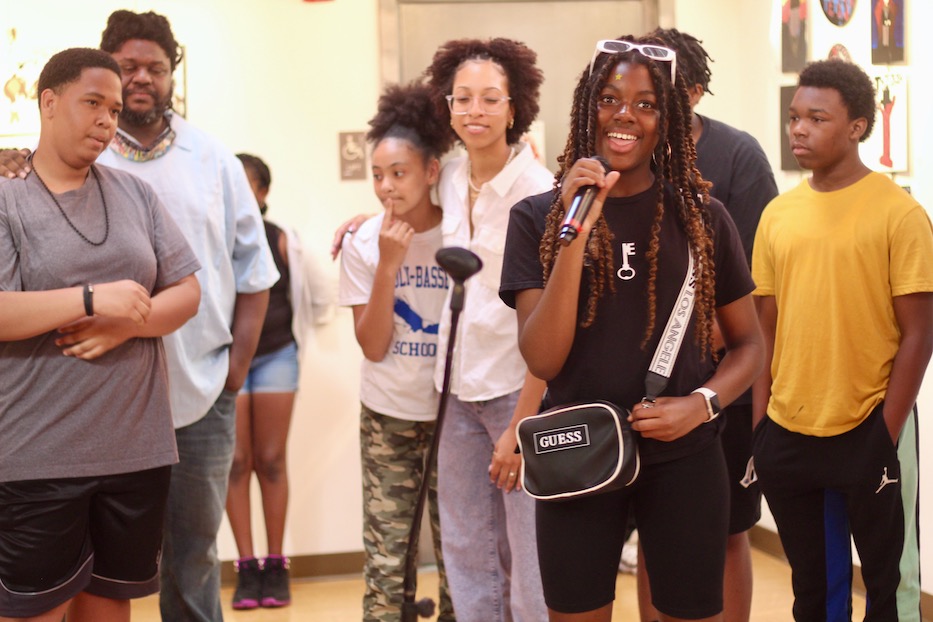
ConnCAT | Culture & Community | Education & Youth | Music | Arts & Culture | ConnCORP | History | Arts & Anti-racism
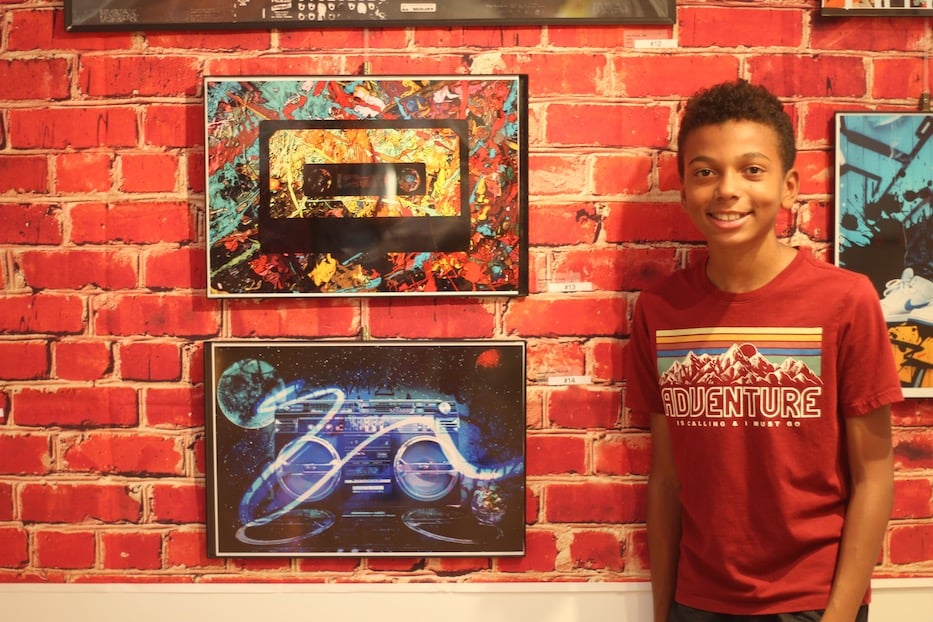
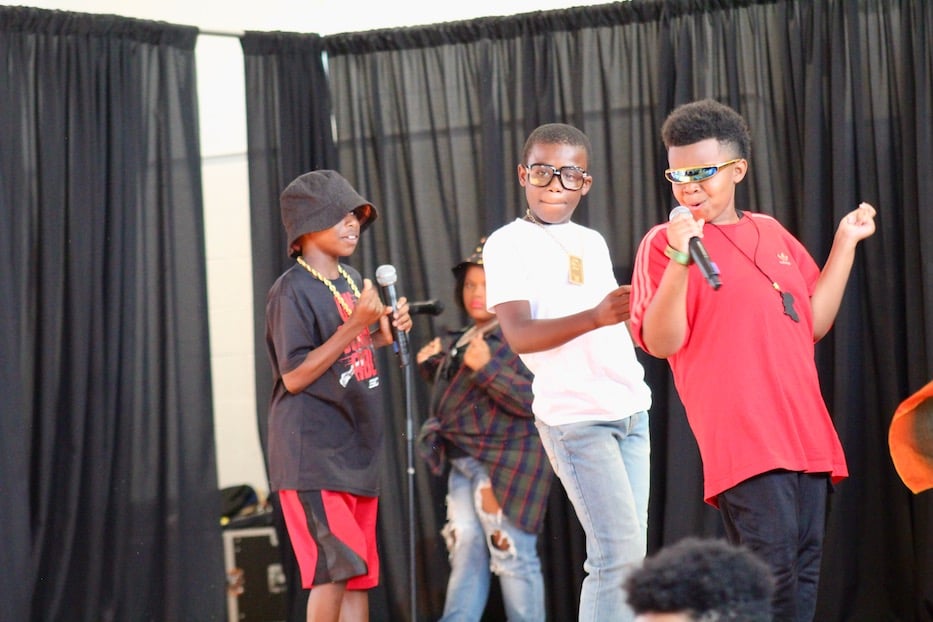
Top: Isaac Williams with his artwork. Bottom: Jace Jones, Joseph Murphy, Nehemiah McLaurin start off the show. Lucy Gellman Photos.
At first, the cassette tape looked as if it was coming right out of the wall, its surface dancing with dabs of orange, yellow and brown. Paint splatters criss-crossed the background, color pulsing against a brick-patterned drop cloth. In a frame beneath it, sound waves swirled around a boombox in ribbons of pure light. The knobs seemed close enough to touch.
When 11-year-old Isaac Williams looked at it, he could see a whole movement evolving before his eyes.
This year, Williams was one of 68 youth in the Connecticut Center for Arts & Technology's (ConnCAT) summer arts program, where students honored the birth, evolution, and 50th anniversary of hip hop across media from July to August. Last Wednesday through Friday, they unveiled a final showcase celebrating the genre, from visual art to dance, storytelling, and song.
It paid homage to a decades-long history that was born in a rec room in the South Bronx 50 years ago this month, on Aug. 11, 1973. An exhibition of student work, much of which is for sale, will remain on view at ConnCAT’s 4 Science Park home for the next few months (most of the proceeds go back to students). An accompanying performance fêting the art form in song and dance took place at the LAB at ConnCORP last Friday evening.
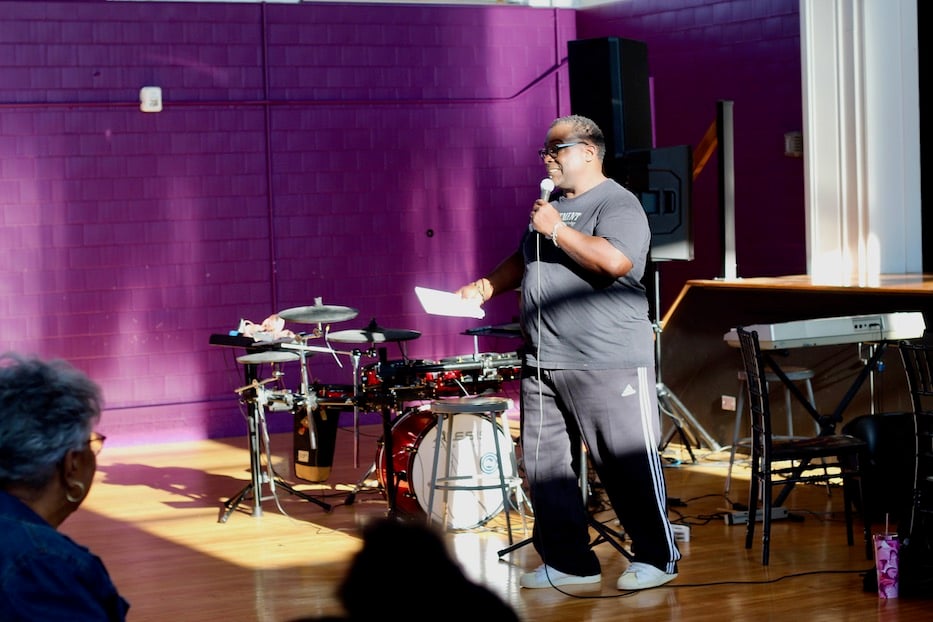
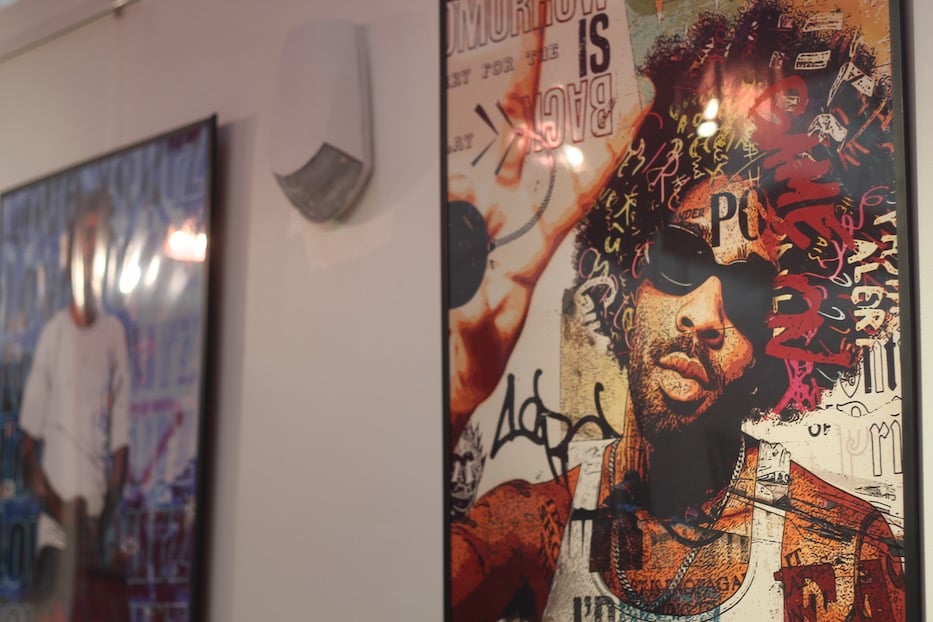
Steve Driffin: "Hip hop for me is the struggle. It’s the beauty. It’s the love. It’s all of it. For me, hip hop is a message."
“Hip hop for me, it talks about our experience,” said ConnCAT Director of Programs Steve Driffin, who designed this year’s summer program with Youth Programs Assistant Rachel Graziano. “The Black experience. Hip hop for me is the struggle. It’s the beauty. It’s the love. It’s all of it. For me, hip hop is a message. It spoke directly to the people and you related to it.”
For Driffin, who has run recent summer programs dedicated to Motown and the Harlem Renaissance, that message was the jumping off point. During his own youth, he was enchanted with the genre, through which 18-year-old Clive Campbell became the legendary DJ Kool Herc at a back-to-school party for his little sister. Growing up in Brooklyn, hip hop became the soundtrack to his adolescence and teenage years. He watched the form evolve, from finding and extending the break to the rap, R&B, and genre-busting collaborations that it birthed.
For him, it was and still is a masterful form of storytelling. Or as he put it simply Friday, “I am hip hop.” So when he started planning this year’s program, focusing on the 50th anniversary of the genre felt like a no-brainer.
For months, he and Graziano brainstormed in his office, where huge sheets of white paper hung over his desk covered in scribbles. They pulled in instructors across the arts, from dancer and educator Nikki Claxton to visual artists Cody Norris and Jasmine Powell.
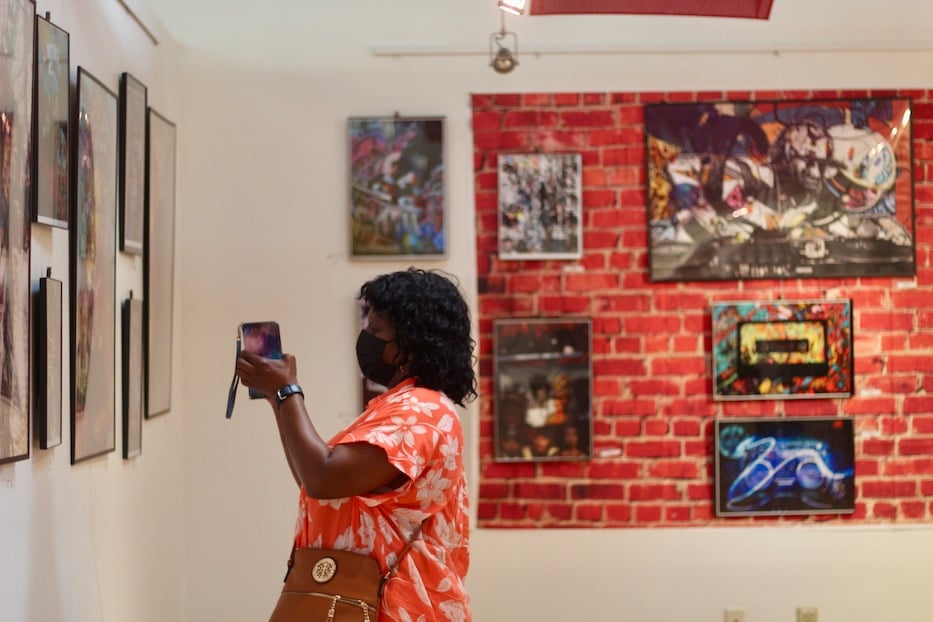
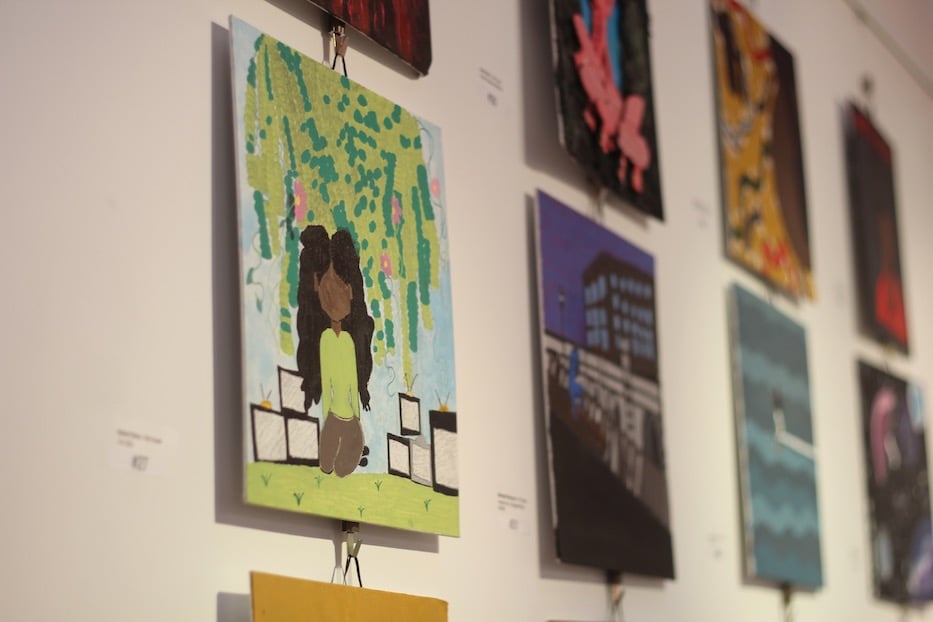
But when campers arrived in early July, “it was tough,” Driffin remembered with a chuckle on Friday. While students may have heard the term hip hop, very few knew what the genre actually was, or connected it to the contemporary soundscape they knew. Names like DJ Kool Herc, Grandmaster Flash, and the late DJ Screw were foreign to them. They didn’t know who members of The Sugarhill Gang were, much less the lyrics to “Rappers Delight.” And when it came to the fundamentals of the movement—breaking, scratching, sampling, battling—it was all new territory.
The team was up to the challenge, Driffin remembered with an easy smile. Musician and master trumpeter William Fluker, who has for years been a teacher at the Science Park space, guided students through the history, from that first sticky and mellifluous Bronx night in 1973 to the generations it inspired, including contemporary artists who still speak about the impact of the art form on their work. For many of the students, it resonated with something deep within them.
“I grew up listening to Motown, and I was just blown away,” said 12-year-old Shiloh Peterson, a rising eighth grader at Engineering and Science University Magnet School (ESUMS) who later brought the house down with a cover of Kool Mo Dee’s “Wild Wild West.” “I feel like hip hop has grown … it brings me back. Hip hop is very inspiring for kids and adults.”
And indeed in the showcase, students embraced and embodied that history in their work across multiple media. At an exhibition opening last Wednesday, New Haven Academy senior and star artist Saria Reid praised the program, rattling off names of hip hop artists as if they were part of her DNA, their lyrics growing in her muscles and bones. Only later, as Reid led a tour of work dotting the exhibition, did her mom mention how much she’d picked up in such a short period of time.
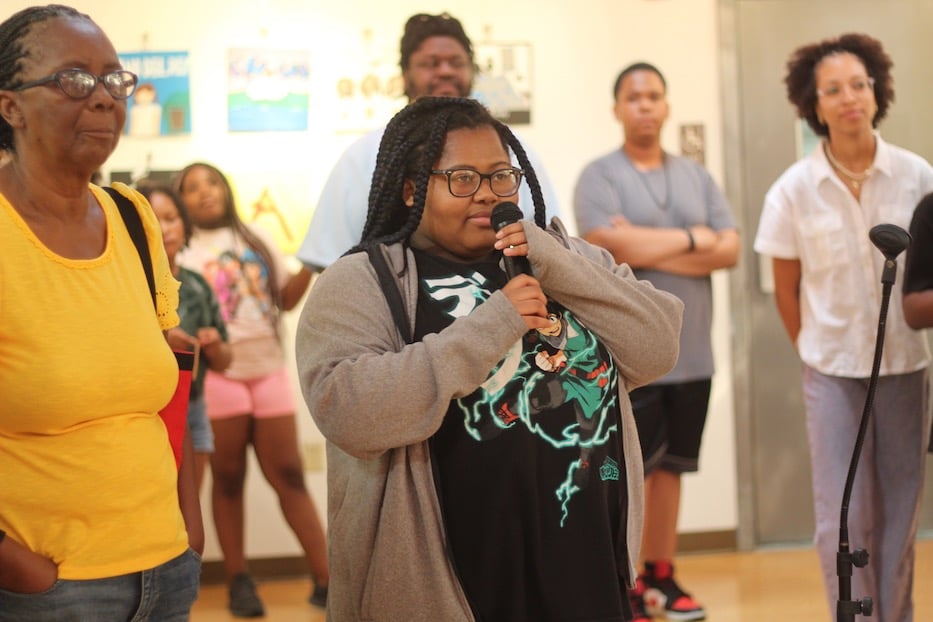
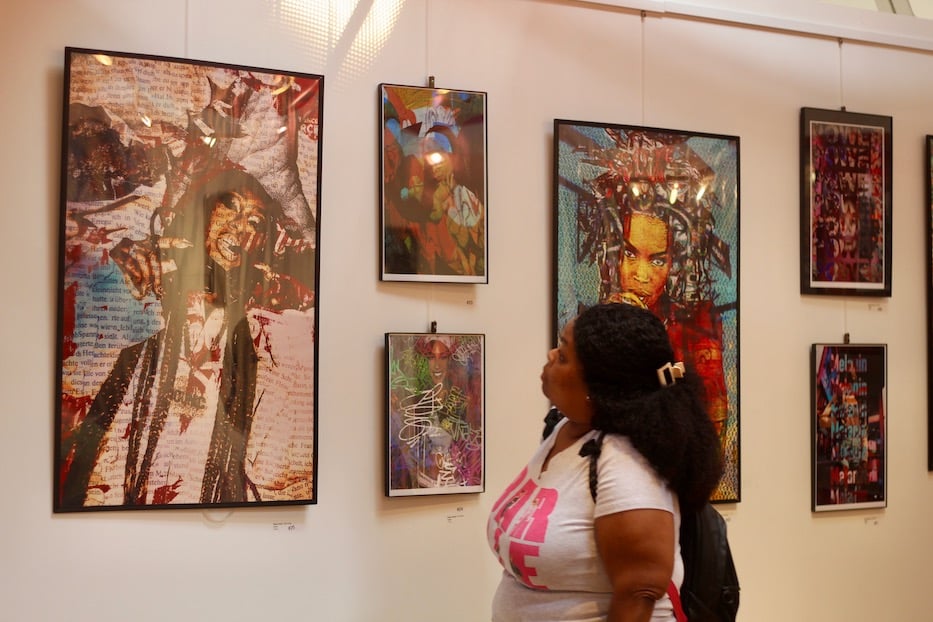
From across the hallway, her portrait of a Fugees-era Lauryn Hill looked out with intense, penetrating eyes, one hand raised to her parted lips. From beneath her raised brows, it seemed almost as if she was preparing to ask the young artist a question. Reid took a deep breath, as if she was anticipating it.
“I’ve just had a really good experience for the past six years,” she said, remembering how she first entered ConnCAT when she was in middle school. As she spoke, the boombox stared back at her, radiating light. Like the portrait of Lauryn Hill, it was one of the compositions she’d left the program proudest of.
Several students, including those who are relatively new to the program, echoed Reid’s gratitude as they showed family, friends, and siblings around the exhibition. Renae Shannon, who is going into the seventh grade at Davis Academy, said she's been hooked on the program for three years, since she was nine years old. This year, artmaking became a form of therapy for her—and rarely happened without music on in the background.
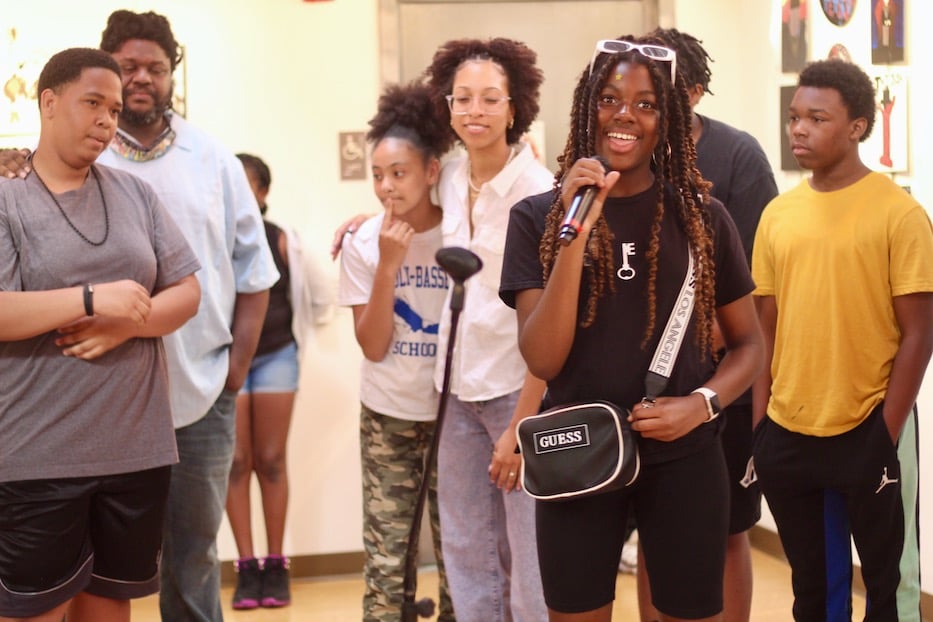
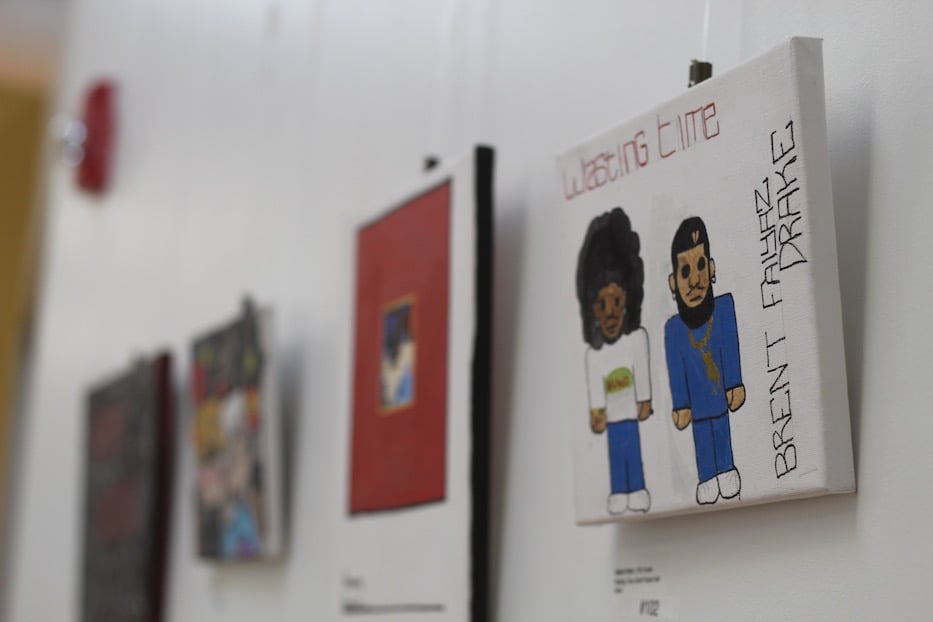
Renae Shannon: "Over the years, I've come to appreciate the program," she said.
Isaac Williams, a rising seventh grader at Betsy Ross Arts Magnet School (BRAMS), said that he was grateful for the chance to dive into vibrant, pulsing colors with digital art, and bring characters to life through his painting.
Shouting out Norris and Powell, he made his way over to a finished print of a cassette tape that had become a heartbeat of the exhibition. When he and Norris started in on the design, he was thinking about the history and legacy of hip hop, which stretches from old vinyl records all the way to Spotify and Apple Music. The cassette tape, its contents neatly wound, felt like a way to clearly share that history.
“I get excited because I know other people are gonna see it,” he said of work.
Others spent time thinking about how they fit into the long history of hip hop—which is also a history of artistry, of mutual trust and respect, of collaboration and community building through the arts. Reid, who is going into her final year at ConnCAT, expanded her discography. Isaac pushed himself beyond the limits of what he visually thought he could do. Nearly blushing, Jamari Rowe remembered falling in love with both the music and the people for a second year in a row.
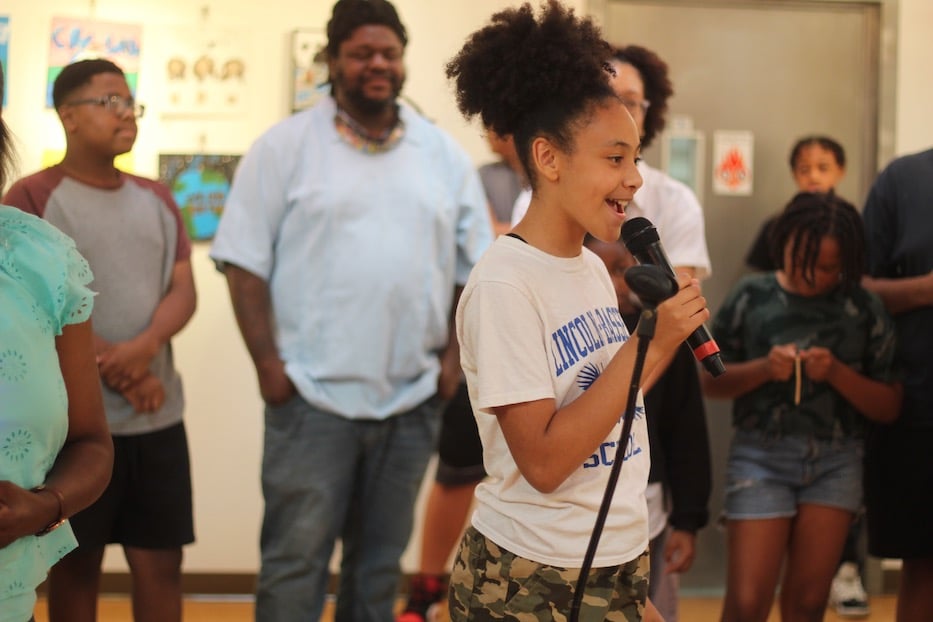
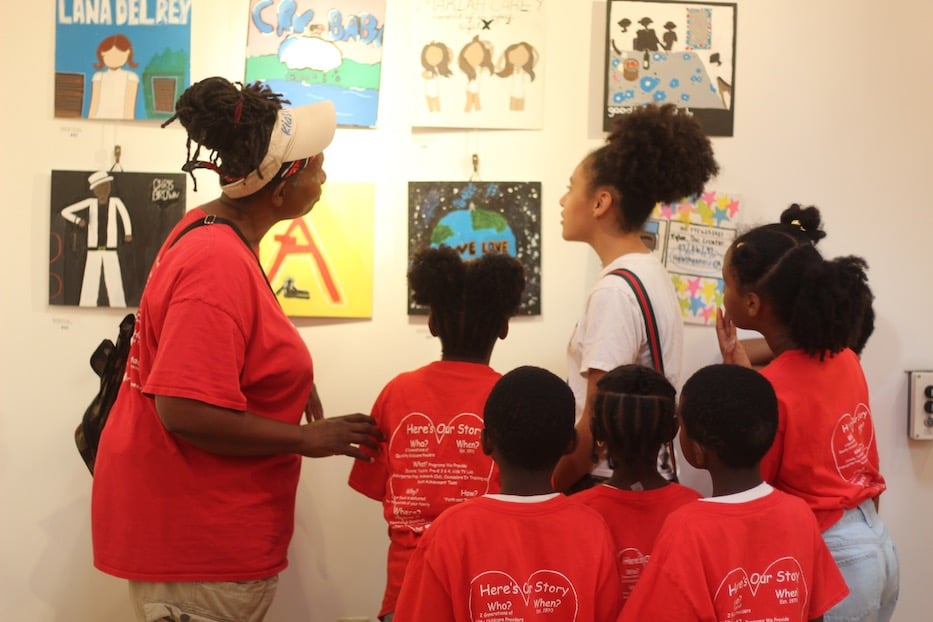
Kim Harris and her young students with 10-year-old Avery Roberson.
As young students from Harris and Tucker School entered the building, co-owner and educator Kim Harris spotted 10-year-old Avery Roberson out of the corner of her eye and beamed. Avery, who starts sixth grade at BRAMS this month, was a student of Harris’ for years. When she began to outgrow the Newhallville-based daycare, Harris suggested ConnCAT’s youth programing.
Avery is one of her star alumni: she was part of a youth-led study that centered social determinants of health, a summit for which was held at the LAB at ConnCORP last fall. Wednesday, she greeted the line of pint-sized attendees in bright red shirts, pointing out her canvas as she chatted with them. Across a square the size of a record sleeve, her take on Mariah Carey’s “Memoirs of An Imperfect Angel,” which came out in 2009, looked back expectantly.
In the image, three versions of the singer morph across the frame, constantly in motion. Her long hair falls around her shoulders, and sweeps onto her cheeks. As Avery described finding and choosing to depict the image—Carey has long spoken about the influence of hip hop on her work, and has been part of its longevity and evolution—Harris absorbed each word.
When Avery paused, she turned around to ask students their thoughts on the piece. At first, most seemed too spellbound to speak. They studied the image, admiring the swoop of Carey’s hair, the suggestion of her bone-white dress. Then they began to chime in, asking Avery about her process, her favorite colors, her time in ConnCAT’s program.
Avery, who said that she wants to come back next year, said that “it means a lot” to see youth artwork on display.
It means a lot to Harris too, she said before leaving. For her as an educator, it’s not just about the fact that it’s youth artwork: it’s also about the importance of a space that specifically nurtures and amplifies young Black voices.
“It’s so important for them to come in here and see themselves reflected like this,” she said.
“We Love You, ConnCAT!”
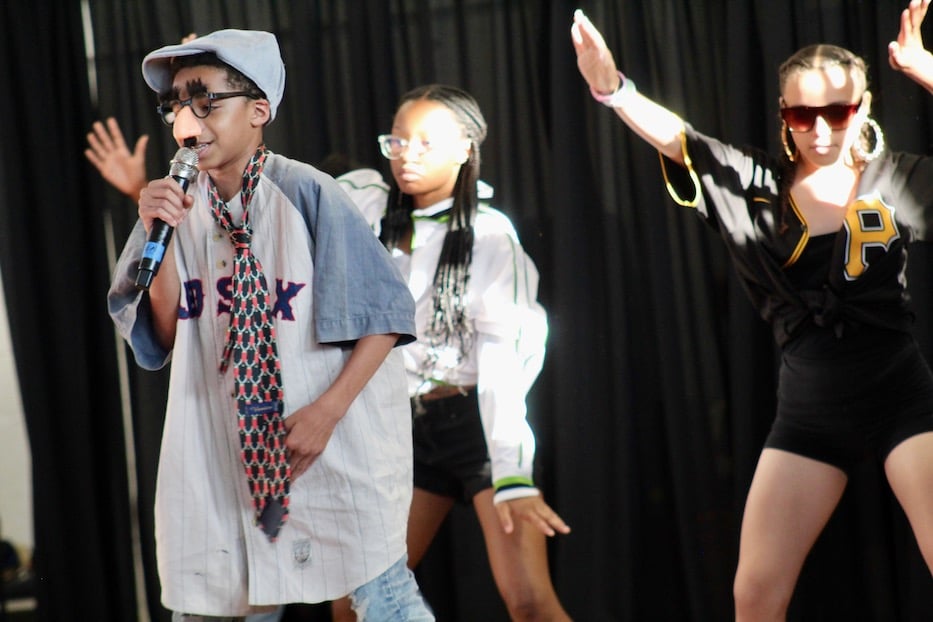
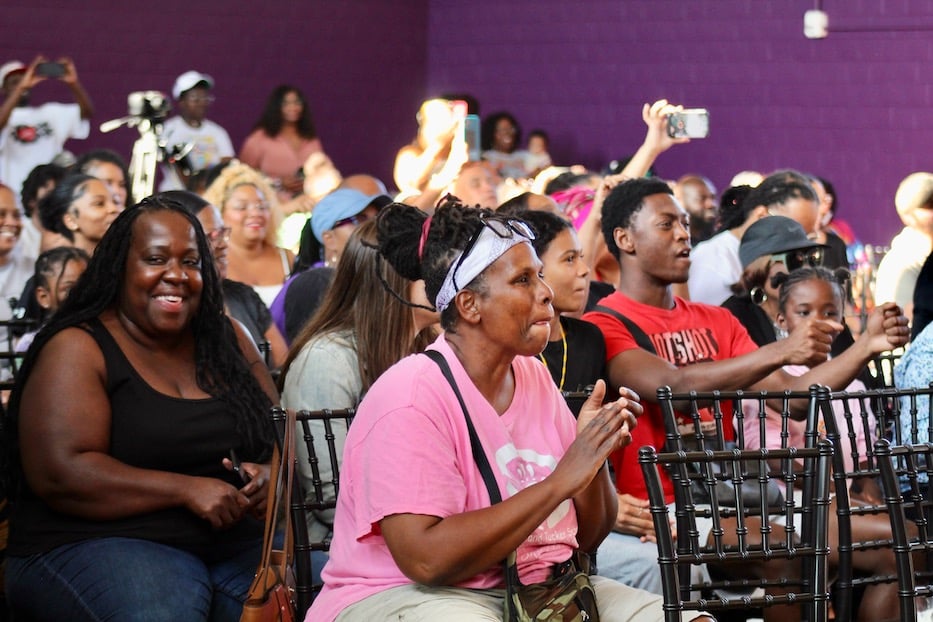
That energy radiated to Friday’s final performance, as students traced hip hop’s growth and evolution from the 1970s to the present. Sweeping onto the stage with co-emcee Iziaya Martin, Reid explained to the audience that attendees and students alike would be doing a little bit of time traveling, carried by song, dance, and audience trivia from the 1970s through the present.
Cheering the emcees on, Driffin added that he didn’t expect a house that full to feel static—he wanted it to feel like an old-school concert, or better yet, a house party with a very good DJ. “I want to see y’all pop-lock, I want to see y’all breakdance,” he said, smiling.
It turned out that the audience had come ready for that advice. Within moments, students Jace Jones, Joseph Murphy, and Nehemiah McLaurin were on stage, keeping the beat as they flowed into a mashup of Chic and The Sugarhill Gang. As they strutted to the lyrics, each took a chance in the spotlight, decades of history running through their pint-sized bodies. In the background, students Erin Jefferson, Sameeyah Brown, and Arielle Hazard entered, and immediately folded themselves into the action, taking on the hook.
In front of them, over 100 attendees erupted in sound, members clapping in time with the beat. No sooner had music started than a small group of Harris and Tucker students sprang up from their seats and began to dance. From the first rows all the way to two dozen standing in the back, the room began to move, as if under the same spell and entirely ready for the magic it would bring.
ConnCAT’s students were just getting started. To the first strains of Kurtis Blow’s “The Breaks,” almost a dozen students ran onstage, their shirts brightly decorated with handmade graffiti designs. Lifting their hands above their heads, they got the room clapping, only to switch it up to a soundbite of Special Ed, followed by Rob Base & DJ E-Z Rock. On stage, they were all but flying by now, arms windmilling as feet scissored in and out of each other at a dizzying speed.
At the very center of the stage, rising Cooperative Arts & Humanities High School freshman Dakari Langley let a smile travel from his lips to his eyes, and then somewhere into the air around him. Somewhere beyond the veil, surely, E-Z Rock was grooving along in appreciation, grateful for the young artists suddenly, unexpectedly keeping their history alive. In front of them, parents and grandparents turned it into a dance party of their own, shoulders swaying and feet tapping to the sound.
That excitement flowed through the performance, a 90-minute odyssey through the art form that jumped from hip hop’s nascent stages to its reverberations today. When students dove into the early 1990s with A Tribe Called Quest’s “Check The Rhime” and Digable Planets’ “Rebirth of Slick,” parents jumped into the lyrics themselves, singing along as Ladybug Mecca came in, pronouncing all of the syllables in cho-co-late taps on my raps.
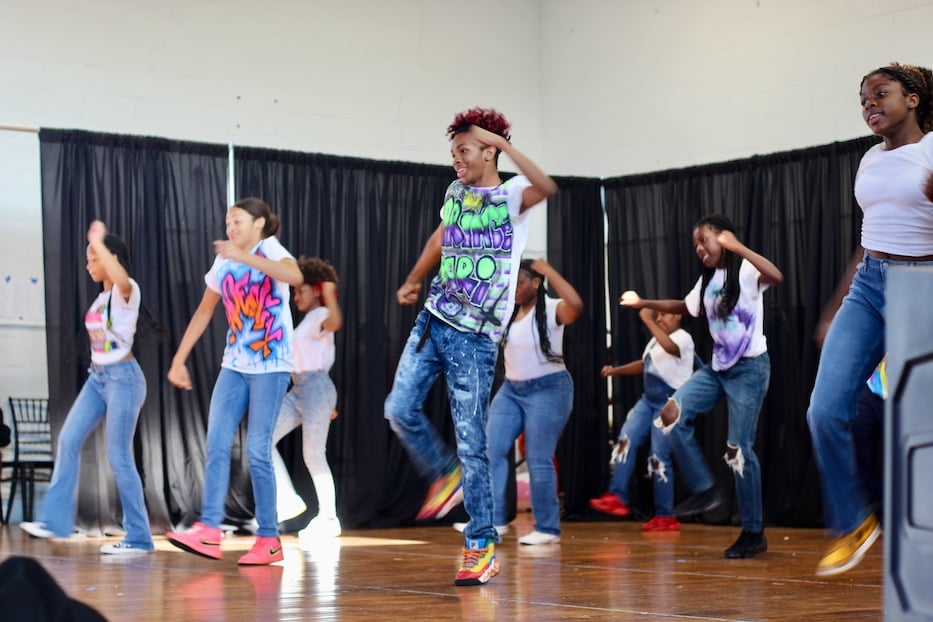
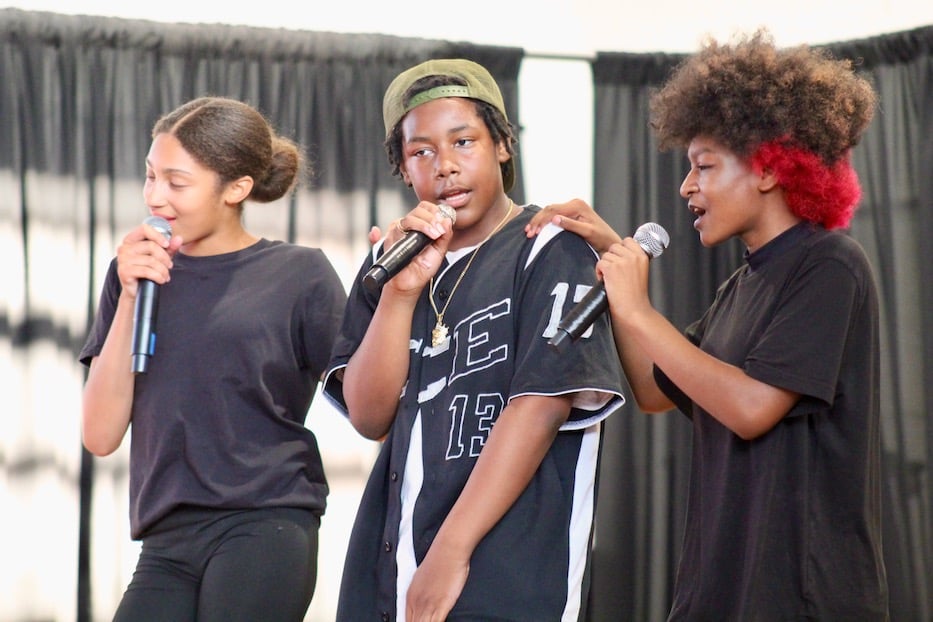
Phoenix Claire, Jamari Rowe and Amari Watts covering Tupac Shakur's "Do For Love."
“C’mon now!” Someone yelled from the third row, and it was enough to get students from Harris and Tucker bouncing along, joining hands as they attempted the same moves that were unfolding onstage. When Montell Jordan faded into Heavy D & The Boyz, Harris herself stood up, drawn by the sound, and began to dance.
In the room, a renovated gymnasium that has been home to fashion shows, town hall discussions, family reunions, and Juneteenth festivities, the lyrics to “Nuttin' but Love” came right up through the floor, until a person could feel them in their body.
At moments, it also seemed like the audience was holding every student on stage—and the students were holding them right back, taking the trip down memory lane that they didn’t even know they needed. When 14-year-old Bailee Parks hopped on the mic for “Killing Me Softly,” the room fell to a hush, reverent as she struck a delicate balance between Roberta Flack’s dreamy, velveteen voice and Lauryn Hill’s soul-soaked, rhythmic cover with Wyclef Jean (as sung by Jeremy Brabham).
They took a beat, then found that by Tupac Shakur’s “Keep Ya Head Up,” they were singing along again. As Janiyah Baskerville rapped on the mic, background singers Jali Rowe, Bailee Parks, and Chamar Landell started in on the chorus. As they leaned in—Ooh, child, things are gonna get easier/Keep-keep ya head up, ooh, child, things'll get brighter—they found that a whole room was singing along with them.
“We love you, ConnCAT!” Shouted Norris. “We love you!”
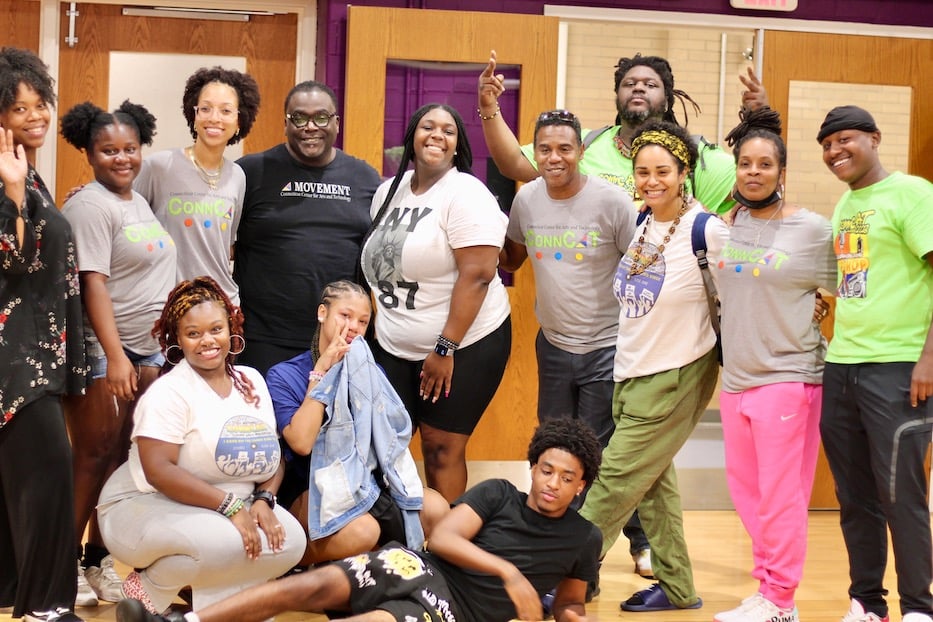
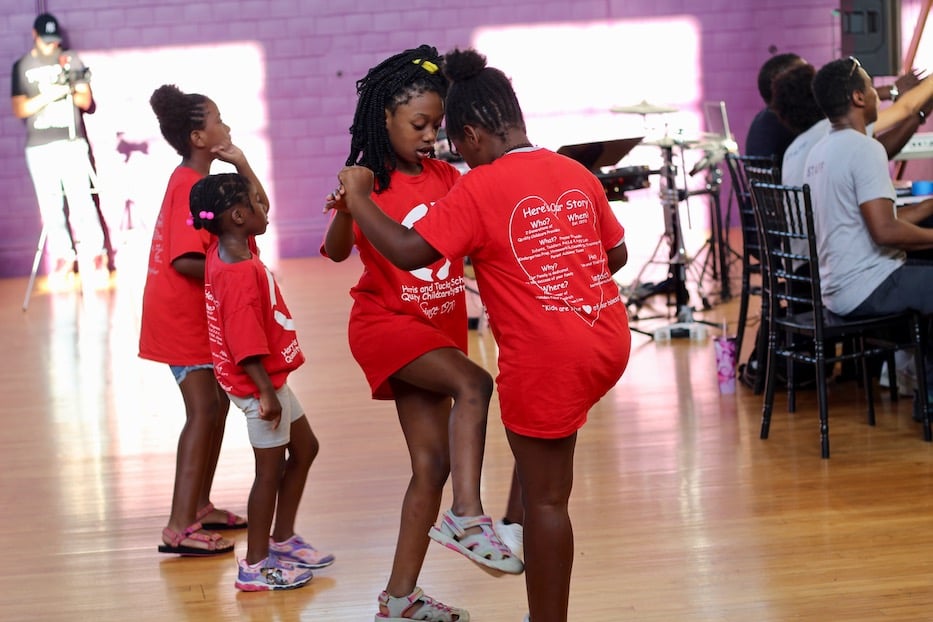
As they kept the show going, Reid and Martin broke up acts with both humor (“I didn’t likethe mid 90s much,” Reid said to quizzical glances and laughter from the audience) and trivia that brought the audience into the show. From Death Row Records and the Fugees, trivia answers flew from the 1990s through the 2000s, with reminders that many of today’s common terms and record labels still pay homage to hip hop’s earliest days.
Jumping from one artist to the next, students also made clear the sheer impact that hip hop has had on contemporary music and dance including the songs that entered the world when they were young children in the late oughts and 2010s.
Gone were the days of Kool Mo Dee, Doug E Fresh and Digital Underground, replaced by TLC (a nod to students Amari Watts, Savannah Nash and Olivia Scott for an epic performance of “No Scrubs”), Destiny’s Child, Alicia Keys and Jay-Z. Paired with dance mixes from the 1990s, 2000s and 2010s, the covers gave attendees a chance to pause, and listen to the pieces with entirely new ears.
In the applause, hugs, and tears that followed the performance—which closed, fittingly, with an ensemble number—several students said that they were leaving the summer program with a new appreciation for music that they’ve long associated with their parents’ and grandparents’ generations, rather than their own.
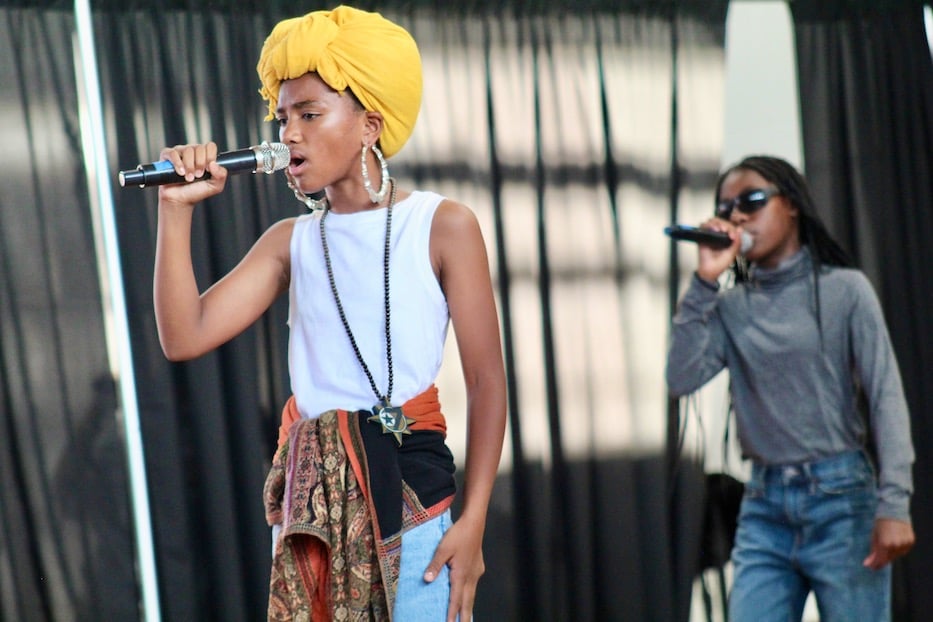
“I listen to the meanings more, and I pay more attention to the beats,” said Savannah Tamia Nash, a rising seventh grader at Hamden Middle School who returned for her second summer this year. “I liked the feeling of being onstage and seeing everyone in the audience.”
She paused to hug classmate Jali Rowe, who had started crying and couldn’t stop. Both of them, she assured Rowe, would be back in a year. “It’s not goodbye! It’s see you later,” she exclaimed.
Around her, other classmates savored their final moments together. While Amari Daesare Watts had listened to hip hop before coming into the program, she said she’s now more likely to gravitate towards it when she’s looking for something to listen to. A rising freshman year at Amistad Achievement First High School, she said she’s especially in love with “old-school” Lauryn Hill, for whom Reid also said she has a very soft soft.
“It’s just like, the vibe it gives is really exhilarating,” Amari said. “As soon as you turn it on, you want to dance.”
A rising freshman at Highville Charter School, 15-year-old Javion Skinner said the program had been so much more than a sonic history lesson. Beyond learning “what separates hip hop from R&B,” he got a crash course in music from the 1980s and 1990s that he hadn’t heard before, and graffiti lettering that makes him think differently about his own creative practice.
“I just like, I feel the music,” he said. “It gets you really hype. It feels good … like I have an opportunity to do more creatively now.”
Learn more about youth programs at ConnCAT here.

